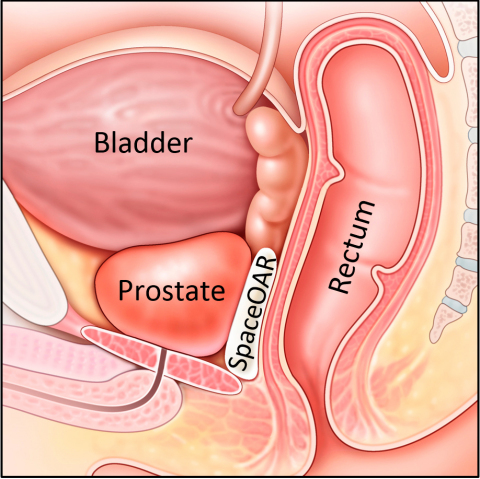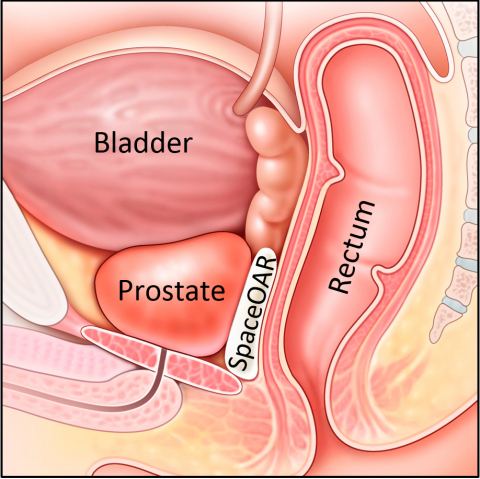TORONTO--(BUSINESS WIRE)--Augmenix, Inc., a medical technology company that develops, manufactures, and sells proprietary absorbable hydrogels that separate and protect organs at risk during radiotherapy, today announced that the first patient in Canada has been treated with SpaceOAR hydrogel at the Princess Margaret Cancer Centre, University Health Network, Toronto. SpaceOAR hydrogel is the first absorbable spacer designed to separate the rectum and prostate to reduce the risk of rectal toxicity during radiotherapy. Princess Margaret will also initiate a 20-patient pilot study to assess the use of SpaceOAR hydrogel in the treatment of prostate cancer.
“Recent clinical data show that SpaceOAR hydrogel helps to significantly reduce the risk of rectal and urinary toxicities and loss of sexual function associated with radiation therapy in the treatment of prostate cancer,” said John Pedersen, CEO of Augmenix. “We are pleased that the first patient to be treated with SpaceOAR hydrogel in Canada took place at the Princess Margaret Cancer Centre, which is globally recognized for innovation and excellence in cancer care.”
Unintended injury to surrounding tissue during radiation therapy can lead to bowel, urinary and sexual symptoms that can affect patient health and quality of life (QOL). With SpaceOAR hydrogel, physicians can help reduce this risk by placing a hydrogel barrier to separate the prostate from adjacent healthy tissue. SpaceOAR hydrogel is initially implanted as a liquid that solidifies into a soft hydrogel that pushes the prostate and rectum apart. It remains stable for three months during radiation therapy and then is gradually absorbed and eliminated by the body.
In January 2017, Augmenix announced three-year post-treatment data from a prospective, randomized, multi-center, patient-blinded clinical trial showing that patients treated with SpaceOAR hydrogel prior to prostate cancer radiotherapy demonstrated significant rectal (bowel), urinary, and sexual benefit through three years of follow up1. During radiotherapy the spacer resulted in a 73.5% reduction in rectal V70 radiation dose and a 49% reduction in median penile bulb radiation dose in patients treated with SpaceOAR hydrogel compared to men who did not receive SpaceOAR hydrogel (Control). Overall patient wellness at three years was assessed by looking at the percent of patients with clinically significant declines in bowel, urinary and sexual QOL domains combined. Three years after radiotherapy, patients that were not treated with SpaceOAR were 8 times more likely to experience significant declines in all three QOL areas (p=0.002). Among men who were sexually potent at baseline, the analysis showed that men in the SpaceOAR hydrogel arm were better able to maintain erections sufficient for intercourse through 3 years of follow-up (p=0.03). Of these men, 66.7% were able to achieve erections sufficient for intercourse at three years compared to 37.5% in the Control arm, a 77.8% relative improvement2.
“The risk of side effects, particularly those affecting the bowel, are key considerations for both clinicians and patients in the decision-making in the treatment of prostate cancer,” said Dr. Peter Chung, radiation oncologist at Princess Margaret and assistant professor, Department of Radiation Oncology, University of Toronto. “Our team at Princess Margaret looks forward to using SpaceOAR hydrogel as indicated as part of our ongoing efforts to bring patients the most effective treatment options while reducing the side effects of radiation therapy.”
About SpaceOAR Hydrogel
Radiation therapy in the treatment
of prostate cancer can cause unintended radiation injury to adjacent
healthy tissue (organs at risk). This injury can lead to a range of
bowel, urinary and sexual symptoms that can affect patient health and
quality of life during radiotherapy, and for years afterward. SpaceOAR
hydrogel is intended to temporarily position the anterior rectal wall
away from the prostate during radiotherapy for prostate cancer and in
creating this space, SpaceOAR hydrogel reduces the radiation dose
delivered to the anterior rectum.
SpaceOAR hydrogel is licensed in Canada, cleared by the U.S. Food and Drug Administration and is currently being used in the majority of leading cancer centers in the United States. It is CE marked in the European Union and approved in Australia. See the Instructions for Use for complete information on potential risks, warnings and precautions.
About Augmenix, Inc.
Augmenix, Inc. is a privately held
company based in the Boston area and focused on the development and
commercialization of radiation oncology products using its proprietary
hydrogel technology. Focusing initially on protection during prostate
radiation therapy, Augmenix next-generation products will address
spacing and marking applications throughout the body to improve
radiotherapy and interventional oncology procedure outcomes. SpaceOAR is
a registered trademark of Augmenix, Inc. More information about Augmenix
and the SpaceOAR hydrogel can be found at http://www.Augmenix.com.
About Princess Margaret Cancer Centre, University Health Network
The
Princess Margaret Cancer Centre has achieved an international reputation
as a global leader in the fight against cancer and delivering
personalized cancer medicine. The Princess Margaret, one of the top five
international cancer research centres, is a member of the University
Health Network, which also includes Toronto General Hospital, Toronto
Western Hospital, Toronto Rehabilitation Institute and the Michener
Institute for Education; all affiliated with the University of Toronto.
For more information, go to www.theprincessmargaret.ca
or www.uhn.ca.





